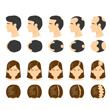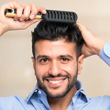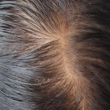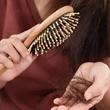Does Ghee Benefit The Health Of Your Hair?
How Beneficial is Ghee for Your Hair?
Overview
Ghee is a traditional Indian preparation churned through evaporation of cow's milk when uniformly heated at a low temperature (kept under 100 C). A trademark from Ayurveda, it's one amongst Panchamrita. Ghee is pure liquid fat, given it's the end product after all water content evaporates from heating milk.
It's more clarified and nutritious than butter, showing beneficial health properties. Ghee for hair has calming effects on the scalp (natural moisturiser). A storehouse of fat-soluble vitamins (A, D, E, K), both topical and oral application of ghee, enhances your hair texture and volume.

Ingredients of Ghee 1
A teaspoon (5.69 g) of pure ghee contains:
- Fat content is 5g
- 42 calorie worth of energy
- A negligible amount (0g) of carbohydrates, fibre, protein, sugar
- Vitamins (A, C, D, E, K)
- Antioxidants
Ghee has anti-inflammatory properties containing butyric acid, reducing inflammation, while linoleic acid lowers bad cholesterol, controls obesity. It reduces symptoms related to arthritis, cataract infection, cancer, and heart ailments.
Benefits of Ghee for Hair 2
Ghee is an amalgamation of essential proteins and heart-friendly fats. Made of ingredients of culinary arts and beautification, ghee for hair is your homemade moisturiser. It treats clogged pores, detangles hair strands, nourishes hair follicles, and enhances hair regeneration.
1. Smooth hair strands
Ghee contains nearly 100% fat. It readily separates tangled hair, reduces frizziness, and eliminates brittle hair. Applying ghee along the length of hair strands affects hair follicles like natural scalp oil. It keeps your hair healthy from roots, besides keeping them moisturised.
2. Thicker hair length
Vitamin E helps thicken hair strands. Hair follicles nourished from the root show thicker girth and tensile, making them resistant to wear and tear. Ghee for hair contains antioxidants, thickening hair follicles enhancing the volume of hair, making it healthy
3. Smiling scalp
Ghee contains vitamins (A, E) which are vital for keeping your scalp healthy. Applying ghee nourishes the scalp, reducing dandruff and lowering hair infections. Anti-ageing creams and hair products contain antioxidants that keep your skin and hair shiny and young.
4. Encouraging natural hair growth
Ghee promotes hair growth because it neutralises scalp problems, thickens hair strands, reduces frizzy hair and hair loss. It provides deep nourishment of hair follicles, making them long while lowering hair loss. It makes your hair enhanced in volume.

How to Apply Ghee to Your Hair? 3
GGhee is a healthy option than butter. Consuming ghee proliferates HDL (high-density lipid) that enhances good cholesterol in your heart. You can apply ghee to your hair both orally and topically.
Oral consumption
- An adult can consume 2-3 teaspoons of ghee daily with staple and topping with food
- Take a spoonful of ghee, warm it, and add it to the dish before consumption.
- Applying ghee to your hair requires taking a spoonful of ghee, melting it and adding it to your scalp.
Topical consumption
- Massage with ghee (use fingertips on your scalp) from hair root to tip.
- Prepare a ghee based hair mask adding, a few tablespoons of ghee, warming it.
- Let it soak for two hours and wash it off with shampoo.

What are the Side Effects of Ghee on Your Hair? 4
Ghee is the purest form of clarified butter. A natural moisturiser, ghee, contains essential nutrients, minerals, and vitamins. But contaminated ghee contains toxic chemicals to have a unique smell of natural ghee. Applying ghee to your hair can affect the dermal health of your scalp. Side effects include:
- Clogging of hair follicles
- Scalp acne
- Hair falls out of clogged pores
- Hair follicles attract dust, turning sticky, making it difficult to manage
- Heated ghee is dangerous for the scalp (burning sensation)
- Hair strands become dirty and prone to fungal problems.
Conclusion
In Ayurveda, ghee has healing properties. Known for its regeneration power, ghee for hair is a natural recipe providing cardiovascular and dermal benefits. Ghee can tolerate more heat than butter for 100% fat content. It makes it preferable to butter for Indian culinary conditions (high temperature of cooking).
Ghee is a natural moisturiser. To sport naturally healthy and shiny hair, consume daily and apply topically conveniently.
Myth Busters HairFall

Androgenetic Alopecia - Everything You Need To Know
Have you been experiencing excessive hair fall over a prolonged period of time? It could be an early sign of androgenetic alopecia. It is a hair loss disorder common in both genders and can lead to progressive thinning and even baldness in some patients if not caught and treated early.

How To Make Hair Grow Faster For Men
A head full of healthy hair is a matter of confidence. Hair has its own mechanism of growing and shedding, and it is when this mechanism is thrown off that growth is hindered. Especially in the case of males, hair growth faces a lot of hiccups that can easily be managed.

Female Pattern Baldness - Causes & Treatments
Have you suddenly noticed an increase in the number of hair strands on your pillow in the morning? Or is your ponytail getting thinner by day? Well, you might be suffering from female pattern baldness. While that does sound scary, identifying it early on is key to treating this condition effectively. So keep reading to know what this is, how you can identify it, and most importantly, what treatments you can avail of to get your beautiful lustrous hair back.

What Are The Reasons For Hairfall?
Almost everyone experiences some amount of hair thinning over the years. Shedding around 50 to 100 single strands of hair per day is considered normal. However, losing more than 150 strands a day, experiencing sudden thinning, or developing circular bald patches on your scalp are reasons for concern. Hair loss occurs when new hair doesn’t grow fast enough to replace the amount of hair you lose daily. Hair can fall due to various reasons, with hereditary hair loss and poor nutrition being the most common hair fall reasons.

Expert Approved Tips For Hair Growth
What can be more debilitating than seeing hundreds of hair strands shedding from your scalp every time you brush your hair? Also, excessive molting occurs during seasonal changes that can be very stressful for you. Although it’s okay to lose between 50-100 strands every day, according to the American Academy of Dermatology, the problem occurs when you start shedding more than normal. But that doesn’t mean you have to feel helpless as there are ways to grow your hair back. Even if you are coping with baldness or alopecia, certain hair growth tips from dermatologists can come to your rescue. Read on to discover how these tips can be your savior when abnormal hair fall problems are in sight.
Trending Videos
+ 4 Sources
'LMRC - GGI-CO-A2-DMA-300001252-300001252-WM-L21-704'
© 2021 Dr. Reddy’s Laboratories Ltd. All rights reserved.